I specialize in creating and strengthening social impact / tech for social good programs, products, designs and strategies
Jump to section: Video Series | Current Work | MLCommons | GitHub Social Impact | Advisory Work | UX Research and Design Work
I have a video series on YouTube about trending topics in tech for social good. In this video on the right/below, I cover challenges and opportunities of using AI to achieve the Sustainable Development Goals. I also have a video explaining the concepts of Responsible AI and AI for Social Good. My latest video why private sector solutions won’t replace US government funding.
- Since February 2025, I have been advising Humane Intelligence, an AI eval organization, on their impact strategy. More info coming soon.
- I am supporting the NYU Center for Health Data Science.
- I have been on the Board of Directors of Radiant Earth since January 2024.

From May – December 2024, I was been the Director of Program Management, AI Safety at the engineering consortium, MLCommons. At MLCommons, I:
- Oversaw and coordinated among eight workstreams that built out the scope, methodology, and software of an AI safety benchmark designed to evaluate large language model safety.
- Created and oversaw a global prompt supplier pipeline. I also created and led a global expression of interest that resulted in three pilot projects I oversaw on prompt generation in Hindi (IN) in hate speech, using clinical forensic psychiatry to evaluate prompt responses, and a landscape analysis of sub-Saharan African readiness for MLC benchmarks. Read more here.
- Created and oversaw all UX research and design work for the v1.0 benchmark. See the portfolio piece here.
- Created organizational policies, served as a public point of contact, and facilitated community meetings.
I was the Director of Tech for Social Good (TSG) on the Social Impact team at GitHub from 2019 – 2023, where I engaged 35,000+ people in six continents through five cutting-edge programs I created. Each program leveraged GitHub’s core products, services, and communities to help achieve the Sustainable Development Goals (SDGs) and better GitHub against ESG standards, such as SASB. TSG was a collaborative and public-facing team within GitHub Social Impact.
Read about why I started TSG programs below. More info is on the website.*
*Web Archive link as the site appeared in April 2023. May require a page refresh in Safari.
Activating Developers Program
What: Launched in March 2023, the long-term goal of Activating Developers is to empower 50,000 more software developers and other users on GitHub to contribute to social good projects.
Why: 50,000 more social good contributors on GitHub will have a substantial positive effect on the world. I created Activating Developers to reach more technologists who don’t currently work on social good projects, and more people working in the social sector who don’t use GitHub.
Accomplishments: Under Activating Developers, I launched a Digital Public Goods Open Source Community Manager Program* addresses a blocker that prevents digital public goods maintainers from effectively onboarding new contributors. I hosted two parallel events for the Commission on the Status of Women (CSW67), which was GitHub’s first appearance at CSW.
*Web Archive link as the site appeared in April 2023. May require a page refresh in Safari.
UN Engagements
What: TSG has worked with more than 10 specialized agencies, funds, and programs in the United Nations (UN) system, including WHO, UNDP, UNICEF, ITU, and WFP.
Why: The UN drives much of the international global tech for social good work, including COVID-19 response and recovery. The UN and large INGOs are TSG’s equivalent to “enterprise customers” (TSG is not a sales team).
Accomplishments: Launched the first Open Source Programme Office (OSPO) within the UN system, with WHO . Working on the second OSPO with ITU. Made one of the largest corporate in-kind contributions in response to COVID.
Skills-Based Volunteering Program
What: Skills-Based Volunteering (SBV) works like a pro bono consulting program, in which GitHub staff volunteer with social sector organizations on specific, time-boxed projects.
Why: SBV fills project gaps the social sector faces and fosters trust with our communities. We engage GitHub staff in positive, productive, needed projects that allow them to use current skills or develop new skills in different settings than their day-jobs.
Accomplishments: Engaged 200+ GitHub staff in 2022 alone.
Open Source Research Program
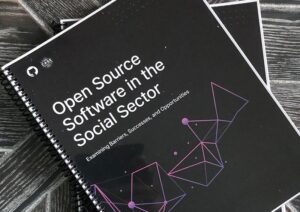
Pictured: First research report. (c) GitHub
What: Conducted two year-long research projects that resulted in me authoring two papers on open source for social good. Download the reports here and here.
Why: This was a critical knowledge gap of the original program I was initially hired to create, Open Source for Good. Few formal research projects had covered this space.
Accomplishments: I engaged two research teams and 100+ experts in eight countries. The research projects have led to me (and GitHub) becoming a thought leader in open source for social good. The reports have been downloaded 500+ times and are regularly cited.
MERL Center
What: An open source community for monitoring, evaluation, research, and learning professionals. Visit the MERL Center website.
Why: In our initial research project, we discovered monitoring and evaluation (M&E) practitioners were the most likely people in the social sector to use open source software (OSS). When we asked M&E practitioners how to support their work, they said we should create a community.
Accomplishments: The MERL Center has grown to 70+ members in 15+ countries, half of whom are women from low- and middle-income countries. It’s the only open source community for MERL practitioners, and has produced 10+ case studies and guides.

From October 2023 – July 2024, I served as an advisor to the OSEE Initiative of ITU to support digital public goods (DPGs) and the creation of open source software capacity centers. I oversaw a group of experts building out the methodology and framework of the program.
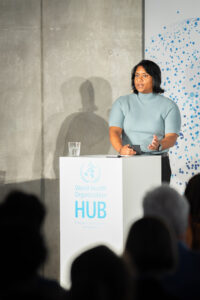
Pictured: Mala in Berlin, June 2023. (c) WHO
In 2023, I served as a Senior Advisor at the World Health Organization, supporting the Open Source Programme Office I helped launch while I was the Director of Tech for Social Good at GitHub (see above). My focus was on software developer, external, and private sector engagement. I also explored AI / ML projects and partnerships for the organization, and conducted a research project on the reputational risk of OSS.
Featured Design Talk
Portfolio

While it was outside of my core job at MLCommons, I took on all UX research and design work for the AILuminate (v1.0 AI safety) benchmark, including the web pages and grader visualizations. This work concluded in November 2024.
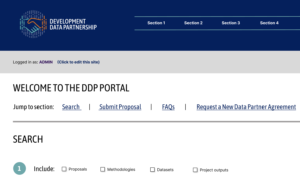
In August 2023, I completed a UX research and design consultancy for the World Bank’s Development Data Partnership to envision what a second version of their portal could look like. I did the prototypes in Figma (public version coming soon). See the “Previous UX Research and Design Work” section below for more UX work examples.
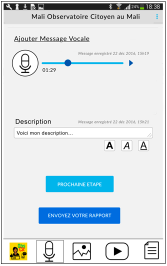
Mali Youth Participation
As part of my then job, I was tasked with the design of an app to allow “jeune leaders” (youth leaders) survey local youth to engage them in local politics. I completely changed my design after an enlightening conversation with one insightful young woman who had done this work before.
Completed: January 2017 (case study added February 2019)

AgResults
AgResults is a Deloitte managed multi-donor initiative that uses prize design and pull mechanisms to incentivize innovation in agriculture. Following a proposal I wrote, AgResults contracted Sonjara to redesign, implement and deploy a new comprehensive website. Read about my work in leading the research and design.
Completed: November 2018
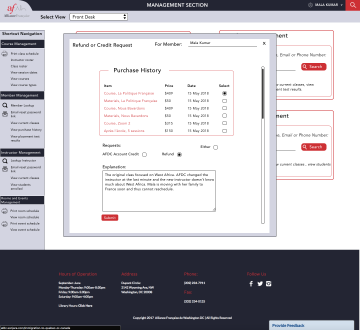
Alliance Française DC (AFDC)
The Alliance Française is a body of the French government tasked with promoting and standardizing the French language around the world. The Washington DC branch, the second largest in the United States, contracted Sonjara with the total web redesign, including eCommerce, course registration and placement test administration. Our work led to the highest course registration in 7 years and in the United States! Click below to read about some of my work as the lead designer and project manager.
Completed: September 2018
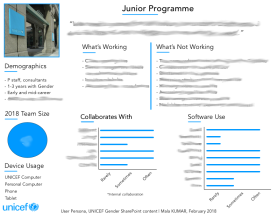
UNICEF Gender
Since December 2017, I have worked with the UNICEF Gender team as a SharePoint designer. In this role, I am creating a new content repository, including its information architecture, taxonomy/tags, flows (points of automation), and user permissions. I’m also in charge of leading the redesign of the front-end of the SharePoint Gender website, as UNICEF is making a transition to SharePoint Modern in late August. As a UX designer, I have used a number of UX research tools to inform my design.
Completed: October 2018

UNICEF Innocenti
I was consulted by The Bassiouni Group in NYC for a project with UNICEF Innocenti, the research arm of UNICEF. In this role, I designed the digital, browser-based version of an evidence gapmap on adolescent wellbeing. This entailed all of the UX and UI of the design, including user research and testing, taxonomy, information architecture and prototyping of both the front and back-ends. I was also responsible for working with the software development firm in a project management capacity to help them develop, implement and deploy the tool.
Completed: October 2017
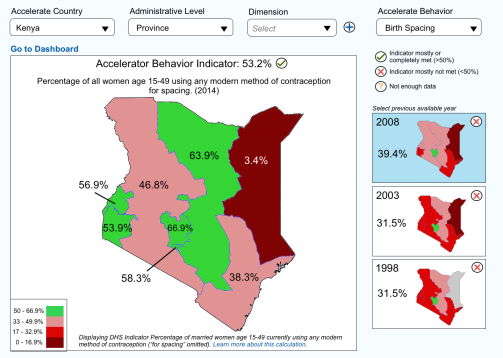
Accelerate, USAID
As one of the in-country team members for three mission trips to Ghana and Kenya, I worked on data visualization and building a better user experience for the online tools for The Accelerate Project, which is a five-year USAID project to help USAID country offices think about their child and maternal health programs using behavior change as the basis of their decision making. The project is ongoing.
LGBTQI UN Staff Rights Platform
I am currently designing a browser-based software, which is the digital mapping component of a project that is defining standards of best practices for LGBTI UN staff rights, and is in collaboration with UN-Globe and Fordham Law School. As a co-creator of the project, I am using my cross-disciplinary knowledge in international development and technology to define the taxonomy, information architecture, visual design and all other UX/UI decisions of the front-end and back-end of both the desktop and mobile versions of the software.
Prototype completed: February 2016, updated March 2019
UX Design Portfolio Piece | Background | Read about it on the MERL Center
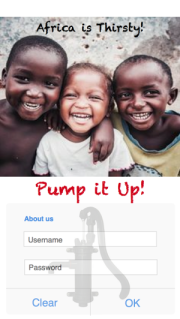
Superficial/Substantive Tech
As part of Art-A-Hack’s summer 2016 session, I led a project team examining “superficial” and “substantive” uses of technology. Our team of four created an experience using an original, interactive virtual reality scene, an app prototype, a pitch deck and several supporting documents around a fake, satirical company called Pump It Up! Read more about the project.
Completed: August 2016
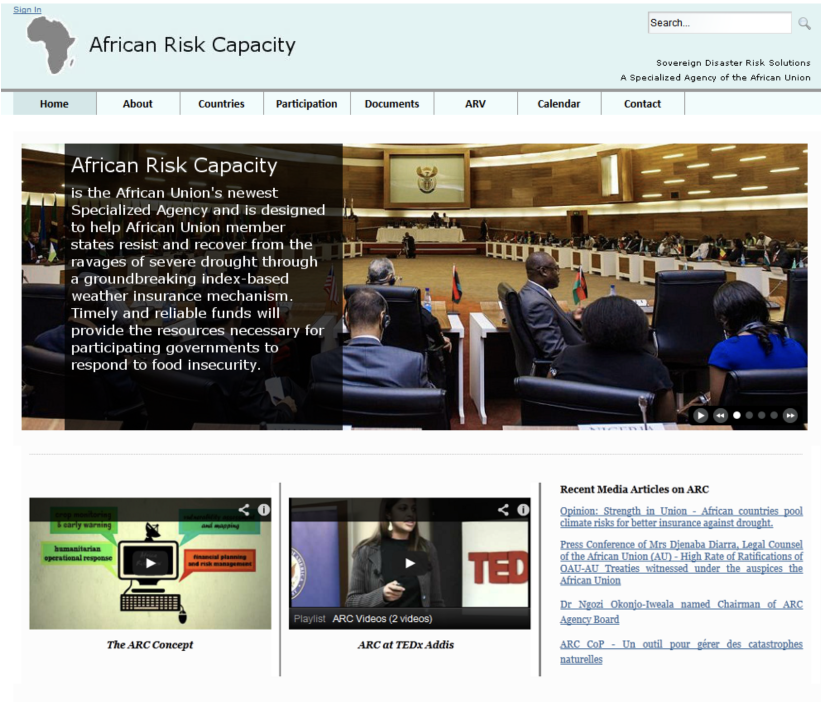
African Risk Capacity
My role as a Programme Officer of the African Risk Capacity of the UN World Food Programme and African Union partially entailed the creation and maintenance of all content of the information website, including the information architecture, visual design, and UX/UI of the site. In addition, I created and monitored the analytics and social media accounts. In its first year since the April 2012 launch, the website had more than 4,500 unique visits in 90+ countries, a large accomplishment given the nascent stage of the project and the niche nature of the work.







